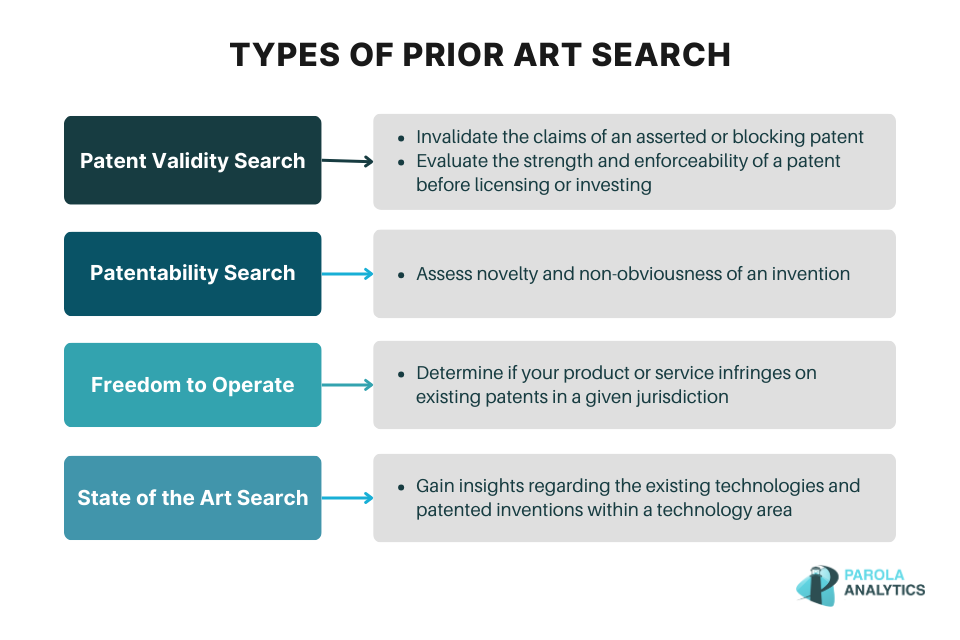The term “prior art” is central to patents, influencing numerous aspects of intellectual property.
Its existence significantly impacts which innovations are granted patent protection, which patents are deemed valid and enforceable, or whether a business can safely launch a product or enter a new market without risking infringement, and so on.
This guide discusses prior art and the prior art search process, and their crucial role in an effective IP strategy.
The term “prior art” refers to any publicly available information, which includes patents, patent applications, scientific literature, technical publications, product manuals, and other technology disclosures that describe similar or related inventions or technologies.
In the United States, the legal definition of prior art is set out in 35 U.S.C. § 102, which defines prior art as public disclosures that are “patented, described in a printed publication, or in public use, on sale, or otherwise available to the public before the effective filing date of the claimed invention.”
In the different stages of the innovation cycle, a prior art search may be conducted to serve various purposes:
Depending on the specific objectives, prior art searches can be categorized into four distinct types, each serving a different purpose:

A patent validity or patent invalidity search is conducted to assess the validity and therefore, the enforceability of an existing patent. One of most common reasons for conducting this type of prior art search is in aid of patent litigation or in the event of a patent infringement suit.
In a patent infringement suit, a defendant may choose to declare non-infringement. Another course of action is to invalidate the claims of the asserted patent. In order to invalidate the claims of a patent, there must be evidence of prior art.
Apart from patent litigation in federal courts, the defendant may opt to use the patent invalidation mechanisms provided by the USPTO such as the inter partes review and post grant review, among others. These post grant proceedings are held before the Patent Trial and Appeal Board (PTAB) and may offer a faster and cheaper resolution compared to costly patent litigation.
Regardless of where a defendant chooses to litigate, there must be a thorough prior art or patent invalidity search conducted to prove that there is prior art.
A comprehensive patent validity search is a crucial component of of a well-informed IP strategy.
A patentability search, also known as a novelty search, is conducted to identify any prior inventions, publications, or other publicly available information that may be relevant to the invention.
Though this type of search is not a predictor for patentability, it can help a patent attorney evaluate the likelihood of obtaining a patent and provide a patentability opinion. This type of search aims to identify prior art that could potentially hinder the grant of a patent due to lack of novelty or non-obviousness.
A patentability search is a complete must before filing a patent application. It offers valuable insights to strengthen the drafting of the patent application, provide ideas for design-around, etc. It is ideal to conduct this type of prior art search even at the early stages of ideation, allowing for a more informed decision regarding R&D direction.
A freedom to operate (FTO) search, also called a “clearance search” is conducted before introducing a new product or service to the market. This search identifies existing patents and other intellectual property rights that may potentially be infringed by the new product or service.
As patent rights are territorial, this type of prior art search is important before entering a new region or market.
The main focus of this prior art search is to determine if there are existing patents in a given jurisdiction that disclose the same elements as the new product or service.
A freedom to operate search will be the basis for a freedom to operate opinion that will be provided by a patent attorney.
A State of the Art (SOA) search, also called a Collection search, is conducted to assess the existing technical advancements in a particular field. It identifies prior art relating to a certain technology which provides insights regarding the patentability of an invention, infringement risks, evaluation of the inventive step, among others.
This wider scope of a prior art search not only identifies technologies that are similar to your idea or invention, but also “competing art” which are technologies that solve the same problem but in a different way.
Services
Links
Sign up to receive first access to our reports, the latest patent news, and other updates —
all delivered to your inbox.
Sign up now to receive monthly patent news, analysis and free insight reports.
We don’t spam, we promise.
Disclaimer:
1. Parola Analytics and Avontis are distinct entities and operate independently. Any references to Avontis or its services do not constitute a legal partnership.
2. Parola Analytics does not provide legal services. Our services are limited to research and technical analysis. Any information provided by Parola Analytics should not be construed as legal advice.